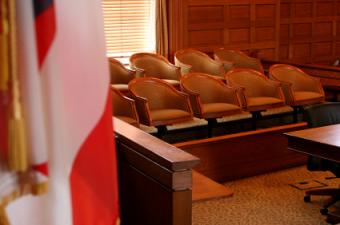Top executives and favored borrowers faced indictment by a federal grand jury on Wednesday for their role in a massive fraud that led to the biggest Virginia bank collapse since 2008.
[IMAGE]According to a release on Thursday from ""SIGTARP"":http://www.sigtarp.gov/Pages/home.aspx, the accused are charged with masking non-performing assets at the Bank of the Commonwealth in Norfolk, Virginia.
The long-running scheme benefited the alleged perpetrators to the detriment of the bank, leading to its eventual failure in 2011. ""FDIC"":http://www.fdic.gov/ estimates the cost to its deposit insurance fund to be $268 million. The 25-count indictment was returned on Wednesday and made public Thursday after the accused parties were taken into custody.
Those parties include Edward J. Woodard, the bank's CEO and chairman, and his son Troy, who was employed by a wholly-owned subsidiary of the bank as a vice president and mortgage loan specialist.
Also brought into custody were EVPs and loan officers Simon Hounslow and Stephen G. Fields, as well as Dwight A. Etheridge and Thomas E. Arney, two ""friends"" of the bank who benefitted from the fraud.
All men are charged with conspiracy to commit bank fraud.
The individuals face varying charges, including false entry in a bank record, unlawful participation in a loan, false statement to a financial institution, and misapplication of bank funds. Each charged contained in the indictment carries a maximum penalty of 30 years in prison if convicted.
""Neil MacBride"":http://www.justice.gov/usao/vae/meetattorney.html, U.S. attorney for the Eastern District of Virginia and one of the agents investigating the case, said the fraud was a breach of trust against the local community.
""The Bank of the Commonwealth's high-risk lending practices resulted in soaring losses after the 2008 financial crisis. Led by former CEO and board chairman Edward Woodward, these bank insiders and their favored borrowers allegedly conspired to hide the rapidly deteriorating financial condition of the bank through fraud,"" said MacBride.
""For more than 30 years, this community put their trust-and their money-in the Bank of the Commonwealth. These charges portray a bank leadership that betrayed that trust for their own profit at
[COLUMN_BREAK]the detriment to their own bank, its shareholders, and the community it served,"" he said.
According to the indictment, leaders at the bank began an aggressive expansion in 2006 beyond its normal focus on Norfolk and Virginia Beach to include branches in North Carolina and the Outer Banks.
By December 2009, the bank's assets reached approximately $1.3 billion, largely built through brokered deposits. Financial institutions must remain well-capitalized to accept and renew brokered deposits due to their high volatility.
The indictment alleges that many of the bank's loans were funded and administered with no regard to industry standards or the bank's own internal controls.
By 2008, the volume of the bank's troubled loans and foreclosed real estate increased, and from 2008 to 2011, bank insiders allegedly masked the bank's true financial condition to avoid any negative impact on investor and customer confidence that could affect its ability to accept and renew brokered deposits.
The indictment also alleges that bank insiders overdrew demand deposit accounts to make loan payments and used funds from related entities (sometimes without authorization from the borrower) to hide the institution's troubled assets.
They also allegedly used change-in-terms agreements to make loans appear current and extended new loans or additional principal on existing loans to cover payment shortfalls.
In addition, the accused allegedly provided preferential financing to troubled borrowers to purchase bank-owned properties. These transactions allowed the bank to convert non-earning assets into earning assets, and the borrowers received cash at closing to make payments on other loans at the bank or for their own purposes.
Borrowers also purchased property owned by bank insiders with loans fraudulently funded by the bank, the indictement alleges.
According to the indictment, the Bank of the Commonwealth sent an application to the Federal Reserve in 2008 requesting approximately $28 million from the Troubled Asset Relief Program (TARP). Based on concern from regulators about the bank's health, the Fed requested that the bank withdraw its application.
The bank lost nearly $115 from 2008 to 2011. The forfeiture notice in the indictment attributes at least $71 million as illegal proceeds of the fraud.
In a press briefing Thursday, Special Inspector General Christy Romero said that although the investigation has seen significant progress, it is not yet over.
""This is an ongoing investigation, and the people of the Tidewater region and in communities across the nation should know that SIGTARP is looking out for them,"" said Romero. ""At SIGTARP, we stand committed to protecting the American people from all fraud related to TARP, whether it happens on Wall Street or Granby Street.""

 theMReport.com Your trusted source for mortgage banking news
theMReport.com Your trusted source for mortgage banking news









